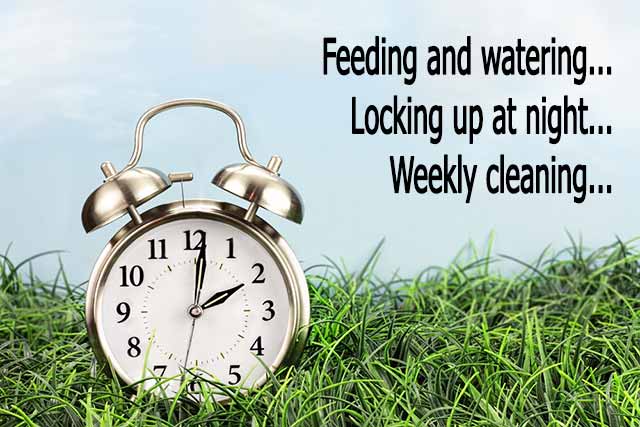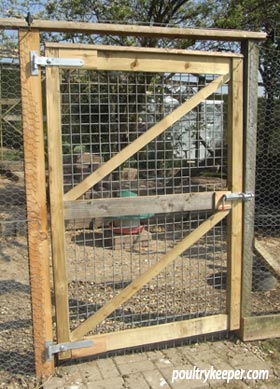Keeping a few chickens in the back yard really is quite straight forward; however there are some things to consider in order to get the right sort of birds for your situation and to keep them in the best possible health to get the most enjoyment out of keeping them.
This page hopes to get you thinking about the types of chickens and their requirements.
Choosing a breed
There are quite literally hundreds of different breeds of chicken to choose from and out of these, many have slightly different requirements.
Some breeds of chicken come only as Large Fowl, and others are also available as Bantams which are a smaller version that look the same. The Orpington for example is available in both large and bantam sizes but the Cochin is only available as large fowl.
There are a handful of ‘True Bantams’ where there is no large fowl equivalent. Examples of these are Dutch Bantams, Japanese Bantams and the popular Pekin Bantam.
Bantams tend to be quite flighty whereas the heavy breeds of large fowl often cannot fly more than a few inches off the ground. Orpingtons for example won’t usually roost very high due to their huge size and will usually just huddle on the floor of the coop.
Every breed is slightly different in the amount of eggs they lay. Typically hens that have been bred for exhibition purposes do not lay as well as utility hens. Bantams of course lay smaller eggs which some people say they prefer for taste.
Hybrids
 Hybrids are chickens that have been created by crossing pure breeds. They are typically crossed to make good layers (the hybrid to the right can lay 280 to 300 eggs!), coloured eggs or attractive hens. Some can be very attractive and they are all generally very hardy. Hybrids are produced in larger numbers that pure breeds and most of the crosses used make the males a different colour as day old chicks so that only females can be raised, therefore reducing costs by about half. A typical hybrid hen will cost you around £15 compare to £25 to £30 for a typical pure breed hen.
Hybrids are chickens that have been created by crossing pure breeds. They are typically crossed to make good layers (the hybrid to the right can lay 280 to 300 eggs!), coloured eggs or attractive hens. Some can be very attractive and they are all generally very hardy. Hybrids are produced in larger numbers that pure breeds and most of the crosses used make the males a different colour as day old chicks so that only females can be raised, therefore reducing costs by about half. A typical hybrid hen will cost you around £15 compare to £25 to £30 for a typical pure breed hen.
Hybrids are a good choice if eggs are one of your priorities although if you think you might like to hatch some eggs, remember hybrid hens do not breed true – you would need the original pure breeds to cross again in order to create more of the same thing so whilst you can hatch their eggs, you may want to consider a few pure breeds for this purpose or consider buying in eggs to hatch.
Free Range
You will of course need a chicken coop but also a secure run or area that is predator proof. A question that people always ask me is “How big should their run be?” I always say “as big as possible within reason.” Even 2 chickens kept in a 2 meter run will soon turn it to mud and get bored (which can introduce vices such as feather pecking and egg eating) but I always believe that it’s fine to provide a small run like this if you can let them out for a few hours each day to free range while you are around. This will give them a chance to forage, supplement their diet and reduce boredom.
Once chickens have settled into their new house, they will go back to it to roost every night so you can let them out in the late afternoon, knowing they will come back to roost at night keeping everyone happy! Some houses and runs have handles or wheels that make them easy to move onto fresh ground which is not only good to prevent a build up of worm eggs and disease but also provides them with a little fresh grass to graze.
Keeping Chickens in the Garden
If you have a ‘nice’ garden that you don’t want spoilt, it’s usually a sensible idea to limit their foraging. Chickens scratch at the ground, make dust baths in the dry soil, leave muck wherever they go and destroy tender young plants. If you can plant in pots, this will help and fencing off part of the garden is usually a good choice to keep them out if you have tender or precious plants. Chickens with feathered feet scratch less and bantams can clear a 6 foot fence if they want to. Heavy breeds of large fowl can be kept out with a knee high fence or box hedge. If you want to stop a bird from flying then you can clip one wing (not both).
So you have decided on the breed that’s right for you and your circumstances. Next, you will need to think about keeping them secure from predators in a suitable chicken house and chicken run – click on a link to go to that page!








hi , we are going to get 3 chickens in the coming weeks,
the area we are putting them in is mainly dirt, i have put some grass seed down, and am hoping we see results
soon. do we have to have grass.?
Grass turns to mud quickly in small areas I’m afraid. You would be better off using a 6 inch deep substrate they can scratch through and can be changed once soiled badly (say once a year?). Wood chippings, rubber chippings, sand or small rounded stones are good but do not use bark since this can harbour mould spores that cause aspergillosis.
Hi
I have a small garden. Most of my produce is grown containers. I have limited space for a coop but would love to keep one or two small hens. Not interested about eggs just the fasination of them as pets. would love ideas and advice. My garden is gravelled with many plants and herbs. but can be adapte for a very small hen house as seen at Pets at home. Please advise if you think I shoulld try to give a couple of bantams a home. Kindest regards.
Lesley
It’s hard to say without seeing the set up Leslie – Maybe this will give some inspiration?
http://poultrykeeper.com/keeping-chickens-faq/how-much-space-do-chickens-need
Great site! Seems to me, though, that there’s one thing that I don’t know that hasn’t been addressed – in order to get eggs, do you need a cockerel? Sorry to be dim, but do hens lay eggs regardless of being fertilised, or is it that you need fertilised eggs if you want hatchers? Thank you!
No, you don’t need a cock Garth.
Sounds rude, forgive me for that but if I were to say Cockerel, that’s a male bird under 1 yr old, so technically I think I’m correct!
Think of a female reproductive system, eggs are produced, it’s only when the male is present that the eggs are fertilised. The female still produces eggs even if there is no male fertilisation.
Commercially, the rules don’t allow fertilised eggs to be sold so for every hen on every farm, there is a male chick that was killed off at 1 day old. It’s a fact that many people don’t even think about.
Hi
We’re thinking of getting a few chickens
We have an old railway embankment at the back of our garden which we have raised beds etc on. Would we be ok having chickens on this? Not a grassy area. Would we need to think about laying turf?
Thanks
Yes, I don’t see why not. You would really need to think about having a substrate you could change every so often though – rubber chippings or wood chippings are the norm.
Hi,
Thanks so much for your website – so much great info!
I have a question which I don’t think has been answered on your site – apologies if I’ve missed it!
My question is how regularly do hens lay? I appreciate this probably varies depending on breed and how happy/health the hen is, but is there a general guideline figure? I’m trying to work out how many hens I need in order to have the number/frequency of eggs I want.
Thanks
Deb
Hi Deb,
Yes, it varies a lot on the breed. Hybrids are very good layers, they are selected to be crosses that lay well compared to pure breeds although some that give extreme egg numbers (300+ per year) will usually start to lay lower quality eggs and fewer of them after a couple of years.
You will get anything between 60-250 per year from pure breeds but 200-330 eggs per year from hybrids, most of them around 250.
Most eggs are produced in spring into summer. Hens slow right down or stop laying during the winter months.
As a general rule, the most a hen can lay is once every 25 hours so an egg gets roughly an hour later every day until she misses out a day every week, resting on that day.